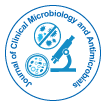
Journal of Clinical Microbiology and Antimicrobials
Open Access
+44-77-2385-9429

+44-77-2385-9429
Opinion Article - (2023)Volume 7, Issue 3
Infective Endocarditis (IE), a relatively rare but potentially lifethreatening condition, is a complex disease that progresses through distinct stages. This intricate journey of infection within the heart demands careful understanding and timely intervention to ensure the best possible outcome for affected individuals [1].
Adherence and colonization
The journey of infective endocarditis begins when infectious agents, typically bacteria, gain access to the bloodstream. This can occur through various means, such as dental procedures, invasive medical interventions, skin infections, or intravenous drug use. However, the risk is significantly elevated in individuals with pre-existing heart conditions, where structural heart abnormalities provide a vulnerable entry point for bacteria.
Upon entering the bloodstream, bacteria begin to circulate throughout the body. In this initial stage, they adhere to damaged heart valves or other susceptible areas within the heart, especially those previously scarred due to prior heart conditions. The bacteria's adherence to the endocardium triggers an inflammatory response, setting the stage for the progression of the infection [2].
Vegetation formation
Once adhered to the endocardium, the bacteria begin to proliferate and create masses known as vegetations. These vegetations consist of a mixture of bacteria, cellular debris, and blood components. As they grow, vegetations can vary in size, and their presence can disrupt the normal function of heart valves and chambers [3].
Vegetations are a hallmark feature of infective endocarditis, and their formation can lead to several clinical manifestations. For instance, they may interfere with the proper opening and closing of heart valves, resulting in murmurs or changes in existing murmurs during a physical examination. Additionally, the turbulent blood flow around vegetations can promote the development of small emboli, which can potentially dislodge and cause damage elsewhere in the body [4].
Complications and systemic effects
As the vegetations continue to grow and the infection persists, individuals with infective endocarditis may experience a range of complications and systemic effects. These can vary in severit and impact multiple organ systems [5].
One of the most concerning complications is the damage to heart valves. Prolonged infection can lead to valve insufficienc (regurgitation) or stenosis (narrowing), compromising the heart's ability to pump blood efficiently. This may result in heart failure, a serious condition that requires immediate medical attention.
Embolic events are another significant concern. Fragments of vegetations or bacteria can break loose and travel through the bloodstream, causing embolisms in various organs. These embolic events can lead to symptoms ranging from minor skin lesions to serious complications in vital organs, such as the brain, lungs, or kidneys [6].
Other systemic effects of infective endocarditis may include persistent fever, fatigue, joint pain (arthralgia), and skin lesions (Janeway lesions and Osler's nodes). These symptoms often result from the body's inflammatory response to the infection and can contribute to the overall clinical complexity of the disease [7,8].
Diagnosis and treatment
Diagnosing infective endocarditis is a multifaceted process that requires careful consideration of the patient's history, clinical presentation, and specialized testing. Common diagnostic approaches include blood cultures to identify the specific bacteria causing the infection and echocardiography, which provides vital imaging of the heart valves and any vegetations present. A comprehensive physical examination, including listening for heart murmurs and assessing for specific skin lesions, can also aid in diagnosis [9].
Once diagnosed, treatment for infective endocarditis is a combination of antibiotics and, in severe cases, surgical intervention. The choice of antibiotics depends on the specific bacteria identified and their susceptibility to different drugs.
High-dose intravenous antibiotics are typically administered to target and eliminate the infecting bacteria. In some instances, surgery may be necessary to repair or replace damaged heart valves, remove infected tissue, or address complications like abscesses [10].
Prognosis and prevention
The prognosis for individuals with infective endocarditis hinges on several factors. Timely diagnosis and appropriate treatment with antibiotics significantly enhance the likelihood of a positive outcome. The type of bacteria causing the infection, as well as the presence of complications, also influence the prognosis. Individuals with underlying heart conditions may require ongoing cardiac care even after recovering from IE [11].
Preventing infective endocarditis is of paramount importance, especially for those at higher risk due to pre-existing heart conditions. Preventive measures include maintaining excellent dental hygiene to prevent dental-related bacteremia, adhering to regular follow-up appointments with healthcare providers, and practicing safe intravenous drug use to reduce the risk of infection [12,13].
In specific situations, individuals at high risk of IE may receive prophylactic antibiotics before dental or medical procedures that could potentially introduce bacteria into the bloodstream. However, the use of prophylactic antibiotics is carefull considered and is generally reserved for cases where the risk of infection outweighs the potential risks of antibiotic use [14].
Infective endocarditis is a complex disease that progresses through distinct stages, each with its own clinical significance. From the initial adherence and colonization of bacteria to the formation of vegetations, complications, diagnosis, and treatment, navigating the terrain of IE requires a comprehensive understanding of the disease's progression. Timely intervention and preventive measures are essential for managing IE effectivel and preventing its potentially devastating consequences [15].
[Crossref] [Google Scholar] [PubMed]
[Crossref] [Google Scholar] [PubMed]
[Crossref] [Google Scholar] [PubMed]
[Crossref] [Google Scholar] [PubMed]
[Crossref] [Google Scholar] [PubMed]
[Crossref] [Google Scholar] [PubMed]
[Crossref] [Google Scholar] [PubMed]
[Crossref] [Google Scholar] [PubMed]
[Crossref] [Google Scholar] [PubMed]
[Crossref] [Google Scholar] [PubMed]
[Crossref] [Google Scholar] [PubMed]
[Crossref] [Google Scholar] [PubMed]
[Crossref] [Google Scholar] [PubMed]
[Crossref] [Google Scholar] [PubMed]
[Crossref] [Google Scholar] [PubMed]
Citation: Aytekin G (2023) Understanding Different Stages of Infective Endocarditis. J Clin Microbiol Antimicrob. 7:166.
Received: 10-Aug-2023, Manuscript No. JCMA-23-27194; Editor assigned: 14-Aug-2023, Pre QC No. JCMA-23-27194 (PQ); Reviewed: 29-Aug-2023, QC No. JCMA-23-27194; Revised: 05-Sep-2023, Manuscript No. JCMA-23-27194 (R); Published: 12-Sep-2023 , DOI: 10.35248/jcma.23.7.166
Copyright: © 2023 Aytekin G. This is an open-access article distributed under the terms of the Creative Commons Attribution License, which permits unrestricted use, distribution, and reproduction in any medium, provided the original author and source are credited.